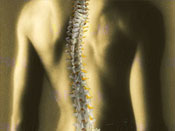Chiropractic Care and Treatment
 Chiropractic care is a health profession that focuses on disorders of the musculoskeletal system and the nervous system, and the effects of these disorders on general health.
Chiropractic care is a health profession that focuses on disorders of the musculoskeletal system and the nervous system, and the effects of these disorders on general health.
Chiropractic care is used most often to treat neuromusculoskeletal complaints, including but not limited to back pain, neck pain, pain in the joints of the arms or legs, and headaches.
Doctors of Chiropractic care – often referred to as chiropractors or chiropractic physicians – practice a drug-free, hands-on approach to health care that includes patient examination, diagnosis and treatment.
The most common therapeutic procedure performed by doctors of chiropractic care is known as “spinal manipulation,” also called “chiropractic adjustment.” The purpose of manipulation is to restore joint mobility by manually applying a controlled force into joints that have become hypomobile – or restricted in their movement – as a result of a tissue injury.
Tissue injury can be caused by a single traumatic event, such as improper lifting of a heavy object, or through repetitive stresses, such as sitting in an awkward position with poor spinal posture. In either case, injured tissues undergo physical and chemical changes that can cause inflammation, pain, and diminished function for the sufferer. Manipulation, or adjustment of the affected joint and tissues, restores mobility, thereby alleviating pain and muscle tightness, and allowing tissues to heal. Chiropractic care providers are specially trained to perform these adjustments and can counsel you about the merits or each adjustment.
Chiropractic adjustment rarely causes discomfort. However, patients may sometimes experience mild soreness or aching following treatment (as with some forms of exercise) that usually resolves within 12 to 48 hours.
In many cases, such as lower back pain, chiropractic care may be the primary method of treatment. When other medical conditions exist, chiropractic care may complement or support medical treatment by relieving the musculoskeletal aspects associated with the condition.
Doctors of Chiropractic care may assess patients through clinical examination, laboratory testing, diagnostic imaging and other diagnostic interventions to determine when chiropractic treatment is appropriate or when it is not appropriate.
Chiropractors will readily refer patients to the appropriate medical provider when chiropractic care is not suitable for the patient’s condition, or the condition warrants co-management in conjunction with other members of the health care team.
Chiropractic doctors practice natural, drugless, non-invasive health care and rely on the body’s ability to self-heal. Sounds ideal, but just how does it work?
We look at the whole picture
Like other health-care providers, we follow a standard routine to gain information about the patient. We consult, review the case history, conduct a physical examination, and we may request laboratory analysis and/or x-rays. Unlike other health-care providers, however, chiropractic physicians also conduct a careful analysis of the patient’s structure and pay particular attention to the spine. We also ask you about your life— Do you eat well? Exercise at all? How do you deal with stress? Do you have children? What do you do for work? And so on.
We seek the origin of the problem
Using this information, a diagnosis is made. Included in the diagnosis is the probable reason for your pain or discomfort. It is important to note that chiropractors seek the origin of the illness in order to eliminate it-we do not simply treat the symptoms. If your roof is leaking, do you simply catch the drips in a bucket for years on end, or do you repair the roof to prevent it from leaking? Similarly, if the migraine headache you’ve had all week is being caused by misaligned vertebra and an irritated nerve, do you continue to take pain killers indefinitely, or do you realign the vertebra to prevent the pain? You get the picture.
We fix the origin of the problem
 Chiropractors have a term for misalignments: subluxations. A vertebral subluxation is a misalignment of the bones that protect the spinal cord. It’s a leak in the roof. Or a kink in the wiring of your nervous system. The severity of the subluxation can vary, and there are a number of potential contributing factors that can be physical, emotional, mental, or chemical. The subluxation can be caused by any number of incidents, from birth trauma to an auto accident to simple repetition or over-use.
Chiropractors have a term for misalignments: subluxations. A vertebral subluxation is a misalignment of the bones that protect the spinal cord. It’s a leak in the roof. Or a kink in the wiring of your nervous system. The severity of the subluxation can vary, and there are a number of potential contributing factors that can be physical, emotional, mental, or chemical. The subluxation can be caused by any number of incidents, from birth trauma to an auto accident to simple repetition or over-use.
What’s the main difference between wellness care and standard medical care? Wellness care seeks to turn on the natural healing ability, not by adding something to the system, but by removing anything that might interfere with normal function, trusting that the body would know what to do if nothing were interfering with it. Standard medical care, on the other hand, seeks to treat a symptom by adding something from the outside – a medication, a surgery or procedure.
Inside Out vs. Outside In
If a patient has high blood pressure, a standard medical approach would be to choose a drug that lowers blood pressure, and ask the patient to take the drug. This may serve to lower the blood pressure, but ignores the underlying cause that is making the blood pressure high, and runs the risk of side effects complicating the person’s recovery. Whether it’s a nutritional issue, faulty control by the nerve system or a manifestation of stress, the medication could decrease the blood pressure, leaving the problem causing the symptom of high blood pressure unaddressed.
The Wellness Approach
Wellness is a state of optimal conditions for normal function… and then some. The wellness approach is to look for underlying causes of any disturbance or disruption (which may or may not be causing symptoms at the time) and make whatever interventions and lifestyle adjustments would optimize the conditions for normal function. That environment encourages natural healing, and minimizes the need for invasive treatment, which should be administered only when absolutely necessary. When the body is working properly, it tends to heal effectively, no matter what the condition. When the body heals well and maintains itself well, then there is another level of health that goes beyond “asymptomatic” or “pain-free” which reveals an open-ended opportunity for vitality, vibrant health, and an enhanced experience of life. This is true for mental and emotional health as well as physical health. While some people may suffer psychological disorders, creating an atmosphere of mental and emotional wellness will address all but the most serious problems.
What is Chiropractic?
What truly differentiates doctors of chiropractic from any other healthcare professionals is the fact that chiropractors are the only professionals who are trained to diagnose and treat what are called spinal subluxations. The word “subluxation” comes from the Latin words meaning “somewhat or slight” (sub) and “to dislocate” (luxate). So the term ‘vertebral subluxation’ literally means a slight dislocation or misalignment of the bones in the spine.
When a subluxation occurs, a chiropractor can correct the misaligned bone and allow it to return to its proper position. This procedure is appropriately called an adjustment, and the adjustment enables the body to heal. The chiropractic adjustment is a quick thrust applied to a vertebra for the purpose of correcting its position, movement or both. Adjustments are often accompanied by an audible release of gas that sounds like a “crack.” The sound sometimes shocks people a little bit the first couple times they get adjusted, but the sensation is usually relieving. Occasionally, minor discomfort is experienced, especially if the surrounding muscles are in spasm or the patient tenses up during the chiropractic procedure. There are times when the audible “cracking” does not occur. This is often due to either significant muscle tightness or that the patient may be having a hard time relaxing during their adjustments. However, the chiropractic adjustment is still important. The leak is fixed. The wiring is fixed. Information is flowing again. To keep the wiring fixed, several adjustments over a course of time may be necessary, in addition to massage, physical therapy, stretching exercises, or strengthening exercises. In the chiropractic world, keeping the problem fixed and preventing its reoccurrence is just as important as the initial remedy.
There are actually five components that contribute to the vertebral subluxation complex (VSC).
- Bone Component – where the vertebra is either out of position, not moving properly, or are undergoing degeneration. This frequently leads to a narrowing of the spaces between the bones through which the nerves pass; often resulting in irritation or impingement of the nerve itself.
- Nervous Component – is the disruption of the normal flow of energy along the nerve fibers, causing the messages traveling along the nerves to become distorted. The result is that all of the tissues that are fed by those nerves receive distorted signals from the brain and, consequently, are not able to function normally. Over time, this can lead to a whole host of conditions, such as peptic ulcers, constipation and other organ system dysfunction.
- Muscular Component – since nerves control the muscles that help hold the vertebrae in place, muscles have to be considered to be an integral part of the vertebral subluxation complex. In fact, muscles both affect, and are affected by the VSC. A subluxation can irritate a nerve, the irritated nerve can cause a muscle to spasm, the spasmed muscle pulls the attached vertebrae further out of place, which then further irritates the nerve and you have a vicious cycle. It is no wonder that very few subluxations just go away by themselves.
- Soft Tissue Component – the VSC will also affect the surrounding tendons, ligaments, blood supply, and other tissues as the misaligned vertebrae tug and squeeze the connective tissue with tremendous force. Over time, the soft tissues can become stretched out or scarred, leaving the spine with either a permanent instability or restriction.
- Chemical Component – is the change in the chemistry of the body due to the VSC. Most often, the chemical changes, such as the release of a class of chemicals called “kinins,” are pro-inflammatory; meaning that they increase inflammation in the affected area.
These changes get progressively worse over time if they are not treated correctly, leading to chronic pain, inflammation, arthritis, muscle trigger points, the formation of bone spurs, loss of movement, as well as muscle weakness and spasm. Chiropractors have known the dangers of the vertebral subluxation complex ever since the birth of the profession. More and more scientific research is demonstrating the tremendous detrimental impact that subluxation have on the tissue of the body. In order to be truly healthy, it is vital that your nervous system be functioning free of interference from subluxations. Chiropractors are the only health professionals trained in the detection, location, and correction of the vertebral subluxation complex through chiropractic care.